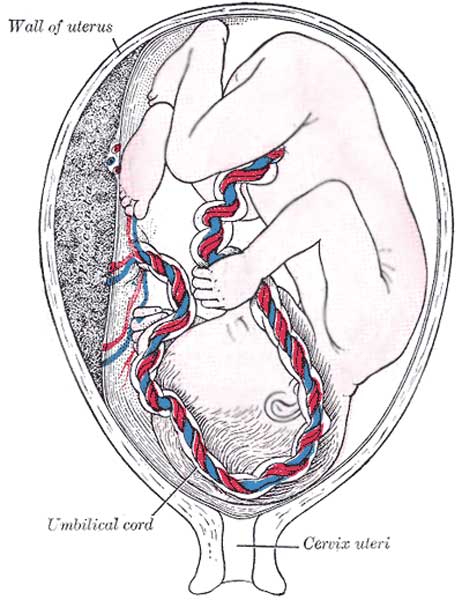File:Gray0038.jpg
Gray0038.jpg (462 × 600 pixels, file size: 45 KB, MIME type: image/jpeg)
Fetus in Utero between Fifth and Sixth Months
Maternal PortionThe maternal portion of the placenta is formed by the decidua placentalis containing the intervillous space. As already explained, this space is produced by the enlargement and intercommunication of the spaces in the trophoblastic network. The changes involve the disappearance of the greater portion of the stratum compactum, but the deeper part of this layer persists and is condensed to form what is known as the basal plate. Between this plate and the uterine muscular fibres are the stratum spongiosum and the boundary layer; through these and the basal plate the uterine arteries and veins pass to and from the intervillous space. The endothelial lining of the uterine vessels ceases at the point where they terminate in the intervillous space which is lined by the syncytiotrophoblast. Portions of the stratum compactum persist and are condensed to form a series of septa, which extend from the basal plate through the thickness of the placenta and subdivide it into the lobules or cotyledons seen on the uterine surface of the detached placenta. |
Fetal PortionThe fetal portion of the placenta consists of the villi of the chorion frondosum; these branch repeatedly, and increase enormously in size. These greatly ramified villi are suspended in the intervillous space, and are bathed in maternal blood, which is conveyed to the space by the uterine arteries and carried away by the uterine veins. A branch of an umbilical artery enters each villus and ends in a capillary plexus from which the blood is drained by a tributary of the umbilical vein. The vessels of the villus are surrounded by a thin layer of mesoderm consisting of gelatinous connective tissue, which is covered by two strata of ectodermal cells derived from the trophoblast: the deeper stratum, next the mesodermic tissue, represents the cytotrophoblast or layer of Langhans; the superficial, in contact with the maternal blood, the syncytiotrophoblast. After the fifth month the two strata of cells are replaced by a single layer of somewhat flattened cells. |
- Links: Placenta Development | Fetal Development
- Gray's Images: Development | Lymphatic | Neural | Vision | Hearing | Somatosensory | Integumentary | Respiratory | Gastrointestinal | Urogenital | Endocrine | Surface Anatomy | iBook | Historic Disclaimer
| Historic Disclaimer - information about historic embryology pages |
|---|
| Pages where the terms "Historic" (textbooks, papers, people, recommendations) appear on this site, and sections within pages where this disclaimer appears, indicate that the content and scientific understanding are specific to the time of publication. This means that while some scientific descriptions are still accurate, the terminology and interpretation of the developmental mechanisms reflect the understanding at the time of original publication and those of the preceding periods, these terms, interpretations and recommendations may not reflect our current scientific understanding. (More? Embryology History | Historic Embryology Papers) |
| iBook - Gray's Embryology | |
|---|---|

|
|
Reference
Gray H. Anatomy of the human body. (1918) Philadelphia: Lea & Febiger.
Cite this page: Hill, M.A. (2024, April 23) Embryology Gray0038.jpg. Retrieved from https://embryology.med.unsw.edu.au/embryology/index.php/File:Gray0038.jpg
- © Dr Mark Hill 2024, UNSW Embryology ISBN: 978 0 7334 2609 4 - UNSW CRICOS Provider Code No. 00098G
File history
Click on a date/time to view the file as it appeared at that time.
| Date/Time | Thumbnail | Dimensions | User | Comment | |
|---|---|---|---|---|---|
| current | 17:46, 18 May 2012 |  | 462 × 600 (45 KB) | Z8600021 (talk | contribs) | |
| 20:53, 21 April 2010 |  | 400 × 519 (60 KB) | S8600021 (talk | contribs) | Fetus in utero, between fifth and sixth months. Category:Historic Embryology Category:Gray's 1918 Anatomy Category:Human Fetus Category:Placenta |
You cannot overwrite this file.
File usage
The following 25 pages use this file:
- 2009 Lecture 8
- 2010 BGD Practical 12 - Second Trimester
- 2010 Lecture 8
- 2011 Lab 12 - Second Trimester
- ANAT2341 Lab 11 - Second Trimester
- ANAT2341 Lab 12 - Second Trimester
- ANAT2341 Lab 4 - Abnormal Placenta
- Anatomy of the Human Body by Henry Gray
- BGDA Practical 12 - Second Trimester
- BGDA Practical Placenta - Diagnostic Techniques
- Fetal Development
- Lecture - Placenta Development
- Placenta - Cord
- Placenta - Membranes
- Placenta Development
- Second Trimester
- Timeline human development
- Yolk Sac Development
- Talk:Timeline human development
- Template:Second Trimester Timeline
- Template:Second Trimester Timeline collapsable table
- Template:Second Trimester table01
- Template talk:Second Trimester Timeline
- Category:Fetal
- Category:Second Trimester

